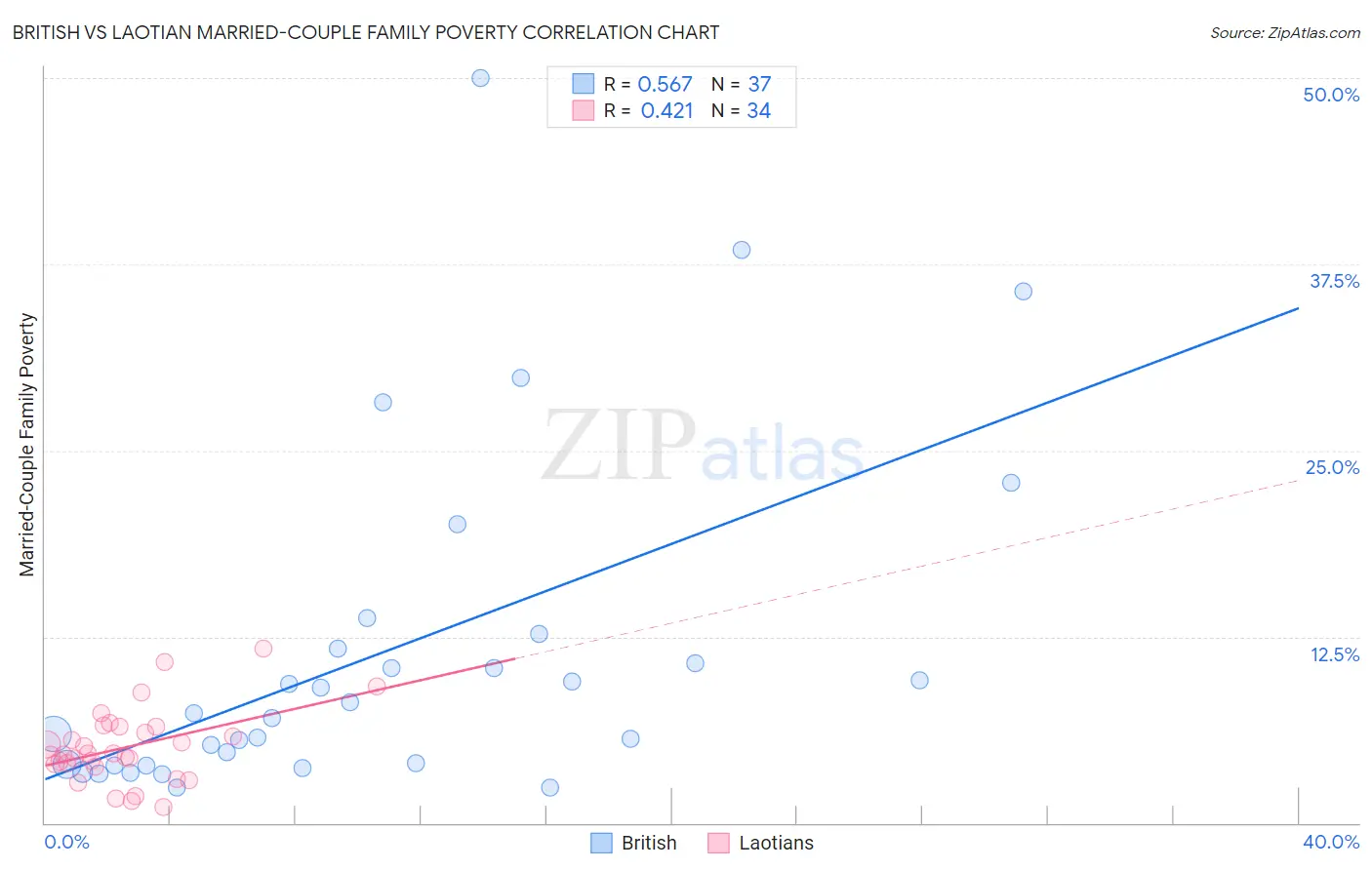British vs Laotian Married-Couple Family Poverty
COMPARE
British
Laotian
Married-Couple Family Poverty
Married-Couple Family Poverty Comparison
British
Laotians
4.3%
MARRIED-COUPLE FAMILY POVERTY
99.8/ 100
METRIC RATING
46th/ 347
METRIC RANK
4.7%
MARRIED-COUPLE FAMILY POVERTY
96.6/ 100
METRIC RATING
108th/ 347
METRIC RANK
British vs Laotian Married-Couple Family Poverty Correlation Chart
The statistical analysis conducted on geographies consisting of 521,525,466 people shows a substantial positive correlation between the proportion of British and poverty level among married-couple families in the United States with a correlation coefficient (R) of 0.567 and weighted average of 4.3%. Similarly, the statistical analysis conducted on geographies consisting of 223,838,659 people shows a moderate positive correlation between the proportion of Laotians and poverty level among married-couple families in the United States with a correlation coefficient (R) of 0.421 and weighted average of 4.7%, a difference of 9.5%.

Married-Couple Family Poverty Correlation Summary
| Measurement | British | Laotian |
| Minimum | 2.4% | 1.0% |
| Maximum | 50.0% | 11.7% |
| Range | 47.6% | 10.7% |
| Mean | 11.5% | 5.1% |
| Median | 7.3% | 4.6% |
| Interquartile 25% (IQ1) | 3.9% | 4.0% |
| Interquartile 75% (IQ3) | 12.2% | 6.4% |
| Interquartile Range (IQR) | 8.3% | 2.5% |
| Standard Deviation (Sample) | 11.3% | 2.5% |
| Standard Deviation (Population) | 11.2% | 2.4% |
Similar Demographics by Married-Couple Family Poverty
Demographics Similar to British by Married-Couple Family Poverty
In terms of married-couple family poverty, the demographic groups most similar to British are Serbian (4.3%, a difference of 0.030%), Immigrants from Japan (4.3%, a difference of 0.050%), Immigrants from South Central Asia (4.3%, a difference of 0.12%), Australian (4.3%, a difference of 0.19%), and Turkish (4.3%, a difference of 0.27%).
| Demographics | Rating | Rank | Married-Couple Family Poverty |
| Immigrants | Northern Europe | 99.8 /100 | #39 | Exceptional 4.2% |
| French Canadians | 99.8 /100 | #40 | Exceptional 4.2% |
| Northern Europeans | 99.8 /100 | #41 | Exceptional 4.3% |
| Scottish | 99.8 /100 | #42 | Exceptional 4.3% |
| Swiss | 99.8 /100 | #43 | Exceptional 4.3% |
| Immigrants | Japan | 99.8 /100 | #44 | Exceptional 4.3% |
| Serbians | 99.8 /100 | #45 | Exceptional 4.3% |
| British | 99.8 /100 | #46 | Exceptional 4.3% |
| Immigrants | South Central Asia | 99.8 /100 | #47 | Exceptional 4.3% |
| Australians | 99.7 /100 | #48 | Exceptional 4.3% |
| Turks | 99.7 /100 | #49 | Exceptional 4.3% |
| Burmese | 99.7 /100 | #50 | Exceptional 4.3% |
| Immigrants | Lithuania | 99.7 /100 | #51 | Exceptional 4.3% |
| Russians | 99.7 /100 | #52 | Exceptional 4.3% |
| Welsh | 99.7 /100 | #53 | Exceptional 4.3% |
Demographics Similar to Laotians by Married-Couple Family Poverty
In terms of married-couple family poverty, the demographic groups most similar to Laotians are Immigrants from Hong Kong (4.7%, a difference of 0.20%), Immigrants from Germany (4.7%, a difference of 0.26%), Immigrants from France (4.7%, a difference of 0.27%), Immigrants from Bolivia (4.7%, a difference of 0.36%), and Pakistani (4.7%, a difference of 0.40%).
| Demographics | Rating | Rank | Married-Couple Family Poverty |
| Yugoslavians | 97.8 /100 | #101 | Exceptional 4.6% |
| Asians | 97.6 /100 | #102 | Exceptional 4.7% |
| Immigrants | Romania | 97.3 /100 | #103 | Exceptional 4.7% |
| Immigrants | Moldova | 97.1 /100 | #104 | Exceptional 4.7% |
| Aleuts | 97.0 /100 | #105 | Exceptional 4.7% |
| Immigrants | France | 96.9 /100 | #106 | Exceptional 4.7% |
| Immigrants | Germany | 96.8 /100 | #107 | Exceptional 4.7% |
| Laotians | 96.6 /100 | #108 | Exceptional 4.7% |
| Immigrants | Hong Kong | 96.4 /100 | #109 | Exceptional 4.7% |
| Immigrants | Bolivia | 96.2 /100 | #110 | Exceptional 4.7% |
| Pakistanis | 96.2 /100 | #111 | Exceptional 4.7% |
| Tongans | 95.9 /100 | #112 | Exceptional 4.7% |
| Immigrants | Nepal | 95.9 /100 | #113 | Exceptional 4.7% |
| Immigrants | Indonesia | 95.1 /100 | #114 | Exceptional 4.8% |
| Taiwanese | 94.8 /100 | #115 | Exceptional 4.8% |